Dynamo Dresden
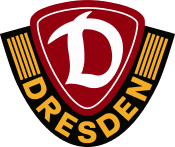 | |||
| Full name | Sportgemeinschaft Dynamo Dresden e. V. | ||
|---|---|---|---|
| Nickname(s) | SGD, Dynamo | ||
| Founded | 1953 | ||
| Ground | Stadion Dresden, Dresden | ||
| Capacity | 32,066 | ||
| Chairman | Andreas Ritter | ||
| Manager | Uwe Neuhaus | ||
| League | 2. Bundesliga | ||
| 2015–16 | 3. Liga, 1st (Promoted) | ||
| Website | Club home page | ||
|
| |||
Sportgemeinschaft Dynamo Dresden e.V., commonly known as SG Dynamo Dresden or Dynamo Dresden, is a German association football club, based in Dresden, Saxony.[1] It was founded on 12 April 1953, as a club affiliated with the East German police,[2] and became one of the most popular and successful clubs in East German football, winning eight league titles.[3] After the reunification of Germany, Dynamo played four seasons in the top division Bundesliga (1991–95),[3][4] but have since drifted between the second and fourth tiers.[5] The club will begin the 2016–17 season in the 2. Bundesliga.
History
Early years (1950–1954)
The city of Dresden had played a significant part in German football before and during World War II with local club Dresdner SC earning national championships in 1943 and 1944. After the war the occupying Allied authorities dissolved organizations across the country, including sports and football clubs like SC, as part of the process of denazification. DSC was reestablished in 1946 as SG Friedrichstadt, but with the eastern part of the country, including Dresden, under Soviet control, authorities considered the club to be too bourgeois. After a riot at the final of the 1950 East German championship, the club was dissolved.[2]
The city needed a new, ideologically safe representative, and a new football club as founded, as part of SG Deutsche Volkspolizei Dresden. A team was assembled with players delegated from 11 other police-affiliated clubs,[2] and quickly established itself as a force in East German football, winning its first cup in 1952.[2] In April 1953, the central sports society SV Dynamo was founded, to which VP Dresden were affiliated, taking the name of SG Dynamo Dresden.[2] Shortly after this the club claimed its first East German title.[2]
This success, though, proved to be the club's undoing. Erich Mielke, head of the Stasi, of which Dynamo were now part,[6] was unhappy that Dresden was enjoying footballing success, while the capital, East Berlin, lacked a strong footballing team.[7] In 1954, Dynamo's team were moved to Berlin, to form Dynamo Berlin.[2][7] Among the players lost to Berlin were Dynamo's first internationals, including Johannes Matzen, Herbert Schoen and Günter Schröter, while the remainder of the club was left to regroup in the second-tier DDR-Liga.[2]
Re-emergence (1954–1969)
Dynamo Dresden were left with a team composed of youth and reserve players, and by 1957 had dropped to the fourth tier, playing in the local Bezirksliga.[2] They began to climb the leagues, though,[2][8] and by 1962 they were back in the DDR-Oberliga,[8] and although this first season ended in relegation, they bounced back immediately.[8] They recovered equally well from another relegation in 1968,[8] and remained in the Oberliga from 1969 until its dissolution in 1991. This relegation came after a fourth-place finish in 1967, which enabled Dynamo's first foray into European football – they entered the 1967–68 Fairs Cup, where they were eliminated by Scottish side Rangers in the first round.[8]
During the 1965–66 season, 11 East German clubs were separated from their parent sports clubs to be designated as Fußballclubs: clubs focused entirely on football, where the country's best talent would be transferred with the object of developing players for the national team. Dynamo Dresden were one of these, although they retained the title of Sportgemeinschaft (SG).[7]
Glory years (1969–1978)
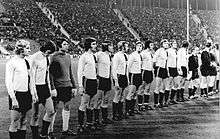
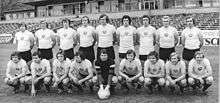
During the 1970s, Dynamo established themselves as one of the top teams in East Germany, under the management of Walter Fritzsch. They won five league titles (1971, 1973, 1976, 1977 and 1978),[3] and two cups, (1971 and 1977).[3] They battled with 1. FC Magdeburg for domination of the league, and became the most popular the side in the country, regularly drawing crowds of 25,000, around three times what other clubs were attracting.[7] They also began to establish themselves as a presence in European football – they played in European competition every year during the 1970s, and eliminated some big names – beating FC Porto, Juventus[9] and Benfica on their way to four quarter-final finishes.[10] During this time Dynamo came up against West German opposition for the first time, losing against Bayern Munich 7–6 on aggregate in the last 16 of the 1973–74 European Cup.[9] On three occasions they were eliminated by English side Liverpool, twice in the UEFA Cup and once in the European Cup,[10] and each time Liverpool went on to win the competition. In 1973, Hans-Jürgen Kreische was the first Dynamo Dresden player to be named East German Footballer of the Year, and was followed by Hans-Jürgen Dörner in 1977.[11] Kreische was the league's leading goalscorer on four occasions,[12] and was named in East Germany's squad for the 1974 World Cup, along with team-mate Siegmar Wätzlich.[13]
History was to repeat itself, though, at the end of the 1970s. Erich Mielke, again jealous that provincial clubs were dominating the league while his beloved Dynamo Berlin were starved of success, began to manipulate the league in favour of the side from the capital.[6][14]
Capital dominance (1978–1991)
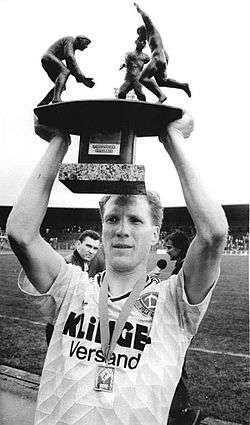
East German football had generally been set up in favour of the "Fußballclubs", who were usually delegated the best players, but the authorities had usually kept out of on-pitch matters. This changed in the late-1970s and 80s though, as players and referees were coerced by the Stasi into helping the cause of Berliner FC Dynamo.[6][14] BFC won ten consecutive titles, from 1979 to 1988. Of all clubs, Dynamo Dresden were the most affected by this, finishing second on six occasions,[5] although they did win the FDGB-Pokal three times (1982 and 1984, 1985).[3] Towards the end of the 1980s, the Stasi's influence was waning,[6] and Dynamo Dresden reclaimed the title in 1989, and retained it in 1990, adding a cup win to complete a double.[4]
By this point the Berlin Wall had fallen, and many of the top players in East Germany took the opportunity to head west. In the summer of 1990, Dynamo Dresden lost two star players, Ulf Kirsten and Matthias Sammer joining Bayer Leverkusen and VfB Stuttgart respectively. With German reunification looming, many clubs in the East changed their name to shed their Soviet image, and Dynamo Dresden changed from SG to the more traditional 1. FC.[4] The Oberliga also changed name for its final season: the league, now called the NOFV-Oberliga, was used to determine which places the East German clubs would take in the unified German league. Dynamo Dresden finished 2nd, behind Hansa Rostock, thus qualifying for the Bundesliga.[4]

Walter Fritzsch had retired in 1978, and was succeeded by Gerhard Prautzsch,[5] who was in turn followed by former players Klaus Sammer (1983–86), Eduard Geyer (1986–90) and Reinhard Häfner (1990–91).[5] The star players of the 1970 were replaced by a new generation, including Torsten Gütschow, Ulf Kirsten, Matthias Sammer, and Andreas Trautmann, although the club lost three key players in 1981: Gerd Weber, who along with teammates Peter Kotte and Matthias Müller had been offered a lucrative contract with 1. FC Köln, intended to flee to the West while in Udine for national team match against Italy in April 1981. The Stasi somehow got wind of this plan, and in January 1981 the three players were arrested at Schönefeld Airport, from where the national team was about depart for Argentina, and banned for life from the DDR-Oberliga. Weber was sentenced to two years' imprisonment. Kotte and Müller, who had decided to stay in Dresden, were nonetheless punished for their knowledge of Weber's plans.[15]
During the 1980s, the club continued to be a regular participant in European football, generally earning respectable results.[10] In the 1985–86 Cup Winners' Cup, however, they were on the receiving end of a shocking defeat against Bayer Uerdingen of West Germany: having won the first leg 2–0, they were 3–1 up at half-time in the second leg, when goalkeeper Bernd Jakubowski was injured by Uerdingen's Wolfgang Funkel. Debutant Jens Ramme was introduced, and proceeded to let in six goals, as the team lost 7–3.[16] In addition to this, striker Frank Lippmann took the opportunity of the match in Krefeld to escape to the west. Dynamo recorded their best ever European performance in the 1988–89 UEFA Cup, beating AS Roma on the way to a semi-final defeat against VfB Stuttgart.[16] Their last European campaign was the 1990–91 European Cup, which ended in defeat to eventual winners Red Star Belgrade. Dynamo's fans rioted at the second leg, which resulted in the club being banned from Europe for the following season.[4]
Bundesliga (1991–1995)

Having been among the top clubs in the East, Dynamo found life in the Bundesliga much harder, struggling both financially and on the pitch. They spent four years at this level,[5] during which they were in a near-constant battle against relegation. Their highest placing was 13th in 1993–94, but the following year they succumbed to the drop, finishing in last place,[4] having gone through three managers (Sigfried Held, Horst Hrubesch and Ralf Minge) during the season.[5] To add to this, the club had accumulated debts of more than 10 million DM, and were denied a license to play in the 2. Bundesliga, and had to drop down to the third tier Regionalliga Nordost.[4] Rolf-Jürgen Otto, the club's president was jailed for having embezzled around 3 Million DM from the club.[4]
While many of the stars of the 1980s had moved west, some remained for Dynamo's Bundesliga tenure, including Torsten Gütschow and Hans-Uwe Pilz, while the club was able to attract players from other Eastern clubs, including Olaf Marschall, René Müller and Heiko Scholz. The fall of the wall brought the influx of Dynamo's first foreign players, and the club saw internationals from Australia (Mark Schwarzer), Poland (Piotr Nowak), Russia (Stanislav Cherchesov) and Sweden (Johnny Ekström), among others.
Ups and downs (1995–2006)
Dynamo sought to regroup in the Regionalliga, and again looked to former players to manage the team, being led by Hans-Jürgen Kreische (1995–96), Udo Schmuck (1996) and Hartmut Schade (1996–1998), but failed to seriously challenge for promotion. In 1998 they finished second in the table, but with 60 points: 32 behind champions Tennis Borussia Berlin. 1999–2000 saw a restructuring of the Regionalliga: the four leagues were to be reduced to two, and Dynamo would have to finish in the top 7 to avoid relegation. Having finished 11th in the previous season they turned to Colin Bell,[4] an English coach who had had some success with youth football in Germany, but he left in March 2000 after poor results and a player revolt.[17] Cor Pot, a Dutchman, was brought in to replace him,[17] and he turned the team around, but it was too late – they finished in eighth place, and were relegated to the fourth-tier Oberliga Nordost-Süd.[17] By this point Dynamo were not even the top team in Dresden: Dresdner SC had returned after reunification, and finished as runners-up in the Regionalliga Nordost in 2000.
Optimism was high, though, after the way the last season had ended, and the slogan "Wir kommen wieder" (we're coming back), was adopted. However, the Oberliga was now highly competitive with VfB Leipzig, 1. FC Magdeburg and FSV Zwickau also having been relegated, and Dynamo couldn't match the consistency of their main promotion rivals Magdeburg and Leipzig. A 2–1 defeat against Magdeburg in February ended their promotion chances, and Pot resigned.[17] With nothing to play for, Dynamo slumped to fifth place.[17] For the following season Christoph Franke was brought in as manager,[17] and led the club to promotion – they won the league[17] with only two defeats, and beat Hertha BSC's reserve team in a playoff to earn their place in the Regionalliga Nord.[17] Dynamo's youth system was particularly successful during this period, with players including Lars Jungnickel, Silvio Schröter, Maik Wagefeld and Daniel Ziebig going on to play at a higher level.
Dynamo finished a respectable 7th in their first season back in the third tier, and followed that with another promotion,[17] finishing second behind Rot-Weiß Essen. Life in the 2. Bundesliga began brightly, with a 3–1 win against MSV Duisburg, but by the halfway point of their first season they were facing relegation, with only 18 points. They recovered strongly in the second half of the season though, and finished in 8th place, thanks in part to signings such as Ansgar Brinkmann, Joshua Kennedy and Klemen Lavric. The 2005–06 season began similarly brightly, as Dynamo climbed to third place with a 2–1 win over 1860 Munich in the Allianz Arena,[17] but this was followed by thirteen matches without a win, resulting in the dismissal of Christoph Franke. Austrian manager Peter Pacult was brought in,[17] and results improved, but Dynamo could not escape the drop, finishing 15th.[17]
Stabilization (2006–present)
Dynamo were back in the Regionalliga with the immediate aim of promotion, and things started brightly, but Peter Pacult left the club after six matches, to manage his former club, Rapid Vienna.[17] He was replaced by Norbert Meier,[17] but Dynamo could not keep up their promotion bid, and finished seventh, due in part to poor away form. Another re-organisation of the league structure was looming, and Dynamo knew they'd have to finish in the top-10 to qualify for the new national 3. Liga. A number of former star players returned, including Lars Jungnickel, Marek Penksa and Maik Wagefeld,[17] but results were not consistent, and Meier was sacked, replaced by former coach Eduard Geyer.[17] Dynamo secured qualification on the last day, finishing eighth,[17] but Geyer was dismissed due to disagreements with the board.[17] In 2007, the club reverted to the name SG Dynamo Dresden.[17]
The club turned to Ruud Kaiser, a Dutchman with a good reputation at youth level, as Geyer's replacement.[17] They played in the first ever match of the third Liga, beating Rot-Weiß Erfurt 1–0 with a goal from Halil Savran,[17] but results were not consistent, and they could only finish in mid-table.[17] The 2009–10 season began badly, and Dynamo were in relegation trouble, so Kaiser was sacked and replaced by Matthias Maucksch, a former player who had had some success with the reserve team.[17] Maucksch managed to drag the team safely from relegation, and finished the season in 12th place. Mauksch led the team to contention for a playoff place during the 2010–11 season, but was sacked in April after a run of five games without a win, and was replaced by Ralf Loose.[18] Loose ended the season unbeaten and secured 3rd place, and a playoff against VfL Osnabrück which Dynamo won 4–2 on aggregate to earn promotion to the 2. Bundesliga.[19]
Dynamo Dresden performed well in 2011–12 2. Bundesliga season. Reaching a stable place the team kept always away from struggling against relegation. While Dynamo Dresden had won the first round DFB-Pokal match against Bayer Leverkusen with 4–3 (after 0–3 in deficit), Dynamo was excluded from the 2012/2013 DFB-Pokal due to fan excesses and abuse of fireworks during the second round match against Borussia Dortmund (0–2) in a first trial. The sentence was later turned into one Game behind closed doors and one away game without own fan support. Virtual tickets were offered to reduce the financial loss, creating the first sold-out Ghost Game in history. The 2012–13 season started poorly for Dynamo and Ralf Loose was sacked in December 2012 after a 3–0 defeat to VfL Bochum with the team in 15th place. He was replaced by Peter Pacult, returning to the club after more than six years. Dynamo's form improved after Pacult's arrival but the team still finished the league as 16th behind Erzgebirge Aue. Both teams had collected the same number of points, so Aue's better goal average made the difference. Due to this Dynamo had to enter relegation play-offs again after just two seasons, incidentally meeting VfL Osnabrück once more—with the roles reversed. Dynamo emerged victorious with 2–1 on aggregate and remains in the second tier for the 2013–14 season. Pacult was sacked in August 2013 after a poor start to the 2013–14 season, and replaced with Olaf Janßen. Jansen was unable to save the club from the drop to the 3. Liga after they lost 3–2 at home to relegation rivals Arminia Bielefeld to drop into 17th place, ultimately costing Jansen his job. Dynamo had drawn half of their matches, winning just five all season.
Under new coach Stefan Böger, the club completely overhauled the squad, and assembled one capable of winning promotion to the 2. Bundesliga. In August 2014, the team managed to knock Bundesliga giants FC Schalke 04 out of the first round of the DFB-Pokal, beating them with 2–1 at the Glücksgas Stadion. The team advanced to third round after beating VfL Bochum as 2–1 at extra time. But, the club was knocked out by Borussia Dortmund. Böger was sacked in 16 February 2015 and was replaced with Peter Németh. The team finished 3. Liga as 6th in 2014–15 season. Dynamo returned to second level after a 2–2 draw at away match against FC Magdeburg in 16 April 2016. Dynamo crowned as champions of 3. Liga after a 4-0 win against Wehen Wiesbaden at home match in 23 April 2016.
Season-by-season record

SV Dynamo
When they were founded as SG Volkspolizei, the club was sponsored by the East German police force, and in 1953, when they became Dynamo Dresden they were part of the SV Dynamo, the sport organization of the security agencies.[6] Dynamo were the most powerful of all the sports societies, and this conferred certain advantages on the club.[7][20] While many former security service clubs have struggled to shed their negative image, particularly Berliner FC Dynamo, Dynamo Dresden and remain popular and well-supported, having come to represent their home city.
Stadium
Dynamo plays at the Stadion Dresden,[21] which was opened in 1923, originally named the Rudolf-Harbig-Stadion after local track and field athlete Rudolf Harbig. The stadium was renamed Dynamo-Stadion by the East German authorities in 1971, but reverted to its former name after reunification. With an original capacity of 24,000, the stadium was rebuilt in the 1990s, in line with DFB and FIFA regulations, and was thoroughly modernised between June 2007 and December 2009. The rebuilt stadium opened on 15. September 2009 with a friendly match against Schalke 04.
Supporters

Dynamo were one of East Germany's best-supported clubs, regularly drawing crowds of around 25,000 during their heyday. Since reunification attendance levels have fluctuated along with the team's fortunes, while they were still one of the most well-supported teams in the lower leagues, drawing an average of around 10–15,000 fans in the 3rd League. Following their 2011 advance to the 2nd League, they were again drawing crowds of 25,000. The 2013–14 season average attendance reached 27,004.[22] Dynamo's supporters have very close relations with FK Sarajevo fans, Horde zla.[23][24]
Relationships with other clubs
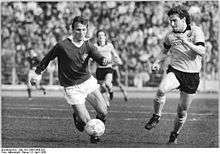
Dynamo Dresden have a particularly fractious relationship with Berliner FC Dynamo, who were formed out of the club in 1954, and were their main obstacle to success in the 1980s, but the two clubs rarely meet these days. Lokomotive Leipzig are traditionally Dynamo's main rivals in the battle for Saxon dominance, although this rivalry extends to other clubs including Chemnitzer FC, Sachsen Leipzig and currently Erzgebirge Aue. In Dresden, Dynamo's main rivals are Dresdner SC, although they are currently ill-matched, as DSC are mired in local football. Another club, SC Borea Dresden were formed out of SG Dynamo Dresden-Heide, a former feeder club for Dynamo, but there is no longer an official connection.
Colours and crest
When they were formed as SG Volkspolizei Dresden, the club wore green and white, the state colours of Saxony,[2] but when the team became part of SV Dynamo they adopted the sports society's wine red colour scheme.[2] In 1968, the club adopted its current colours of yellow and black, the city colours of Dresden.[8]
The club's original crest was built around the shield of the Volkspolizei, to whom they were affiliated. In 1953 they adopted the D logo of SV Dynamo, which was retained until reunification, when its wine red background was replaced with Saxon green. They reverted to the red background in the early 2000s.
Players
Current squad
As of 8 August 2016[25]
Note: Flags indicate national team as defined under FIFA eligibility rules. Players may hold more than one non-FIFA nationality.
|
|
Out on loan
Note: Flags indicate national team as defined under FIFA eligibility rules. Players may hold more than one non-FIFA nationality.
|
Technical staff
| Name | Role |
|---|---|
| Sporting director | |
| Manager | |
| Assistant manager | |
| Goalkeeping coach | |
| Physiotherapist | |
| Physiotherapist | |
| Physiotherapist | |
| Equipment manager |
Dynamo Dresden II
The club's reserve team, Dynamo Dresden II, played until 2015 in the tier five NOFV-Oberliga Süd. It has played at this level since 2009 with a fourth place in 2012 as its best result.[26][27] In March 2015 the club announced that it would withdraw the reserve team from league competition and instead enter it in a friendlies competition with the reserve teams of Chemnitzer FC, Hallescher FC, Sparta Prague, FC Slovan Liberec and FK Teplice.[28]
The team also made a losing appearance in the 1995 Saxony Cup final and won the competition in 2009.
Manager history
Dynamo enjoyed its greatest successes under Walter Fritzsch, capturing the first division DDR-Oberliga title in 1971, 1973, 1976, 1977, 1978, as well as finishing as vice-champions four times. The team also took the East German Cup (FDGB Pokal) in 1971 and 1977.
|
|
|
Notable former players
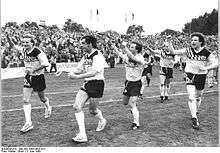
As one of the leading clubs in East Germany, Dynamo Dresden provided 36 DDR internationals,[30] including the country's second most-capped player, Hans-Jürgen Dörner, and its joint second top scorer, Hans-Jürgen Kreische.[31] Twelve Dynamo players won Olympic medals, including six gold medallists in 1976. After German reunification a number of Dynamo players went on to represent the Germany national team, including Jens Jeremies, Ulf Kirsten, Olaf Marschall and Alexander Zickler.
Five Dynamo Dresden players were named East German Footballer of the Year: Hans-Jürgen Dörner, Hans-Jürgen Kreische, Andreas Trautmann, Ulf Kirsten and Torsten Gütschow. Dörner won the award three times, and the latter three players were its last three winners.[11] Kreische and Gütschow were the leading scorers in the DDR-Oberliga seven times between them.[12]
Perhaps the most notable Dynamo Dresden player is Matthias Sammer. He played for the club from 1985 to 1990, during which he won 23 caps for East Germany. He later made 51 appearances for Germany, winning the European Championship in 1996 and played at club level for VfB Stuttgart, Internazionale and Borussia Dortmund. With the latter he won two German titles, the UEFA Champions League and the Intercontinental Cup, and was named European Footballer of the Year in 1996.
Honours
- DDR-Oberliga: 8
- FDGB-Pokal: 7 (Record, shared with 1. FC Magdeburg)
- Deutschland Cup: 1
- 1990
- UEFA Cup
- Semi-final 1989
- NOFV-Oberliga: 1
- Winners 2002
- 3rd Liga: 2
- Regionalliga Nord: 1 (As third tier)
- Runner-ups 2003-04 (promoted)
- Saxony Cup: 3
- Winners 2003, 2007, 2009
- Sachsenliga: 1
- Winners 2009
- GDR Junior Champion: 2
- 1982, 1985
- Junge Welt Junior Cup: 2
- 1976, 1985
- Indoor-Regio-Cup: 1
- 2007
In Europe
| Season | Competition | Round | Nation | Club | Score |
|---|---|---|---|---|---|
| 1967/1968 | Inter-Cities Fairs Cup | 1st round | Rangers F.C. | 1:1, 1:2 | |
| 1970/1971 | Inter-Cities Fairs Cup | 1st round | FK Partizan | 0:0, 6:0 | |
| 2nd round | Leeds United | 0:1, 2:1 | |||
| 1971/1972 | European Clubs' Champions Cup | 1st round | Ajax Amsterdam | 0:2, 0:0 | |
| 1972/1973 | UEFA Cup | 1st round | VÖEST Linz | 2:0, 2:2 | |
| 2nd round | Ruch Chorzów | 1:0, 3:0 | |||
| Last 16 | FC Porto | 2:1, 1:0 | |||
| Quarter final | Liverpool | 0:2, 0:1 | |||
| 1973/1974 | European Clubs' Champions Cup | 1st round | Juventus | 2:0, 2:3 | |
| Last 16 | Bayern Munich | 3:4, 3:3 | |||
| 1974/1975 | UEFA Cup | 1st round | Randers Freja | 1:1, 0:0 | |
| 2nd round | Dynamo Moscow | 1:0, 0:1 (4:3 a.p.) | |||
| Last 16 | Hamburger SV | 1:4, 2:2 | |||
| 1975/1976 | UEFA Cup | 1st round | ASA Târgu Mureș | 2:2, 4:1 | |
| 2nd round | Budapest Honvéd FC | 2:2, 3:0 | |||
| Last 16 | Torpedo Moscow | 3:0, 1:1 | |||
| Quarter final | Liverpool | 0:0, 1:2 | |||
| 1976/1977 | European Clubs' Champions Cup | 1st round | S.L. Benfica | 2:0, 0:0 | |
| Last 16 | Ferencvaros | 0:1, 4:0 | |||
| Quarter final | FC Zürich | 1:2, 3:2 | |||
| 1977/1978 | European Clubs' Champions Cup | 1st round | Halmstads BK | 2:0, 1:2 | |
| Last 16 | Liverpool | 1:5, 2:1 | |||
| 1978/1979 | European Clubs' Champions Cup | 1st round | FK Partizan | 0:2, 2:0 (5:4 a.p.) | |
| Last 16 | Bohemian F.C. | 0:0, 6:0 | |||
| Quarter final | FK Austria Wien | 1:3, 1:0 | |||
| 1979/1980 | UEFA Cup | 1st round | Atlético Madrid | 2:1, 3:0 | |
| 2nd round | VfB Stuttgart | 1:1, 0:0 | |||
| 1980/1981 | UEFA Cup | 1st round | FK Napredak Kruševac | 1:0, 1:0 | |
| 2nd round | FC Twente | 1:1, 0:0 | |||
| Last 16 | Standard Liège | 1:1, 1:4 | |||
| 1981/1982 | UEFA Cup | 1st round | Zenit Leningrad | 2:1, 4:1 | |
| 2nd round | Feyenoord Rotterdam | 1:2, 1:1 | |||
| 1982/1983 | UEFA Cup Winners' Cup | 1st round | B93 Kopenhagen | 3:2, 1:2 | |
| 1984/1985 | UEFA Cup Winners' Cup | 1st round | Malmö FF | 0:2, 4:1 | |
| Last 16 | FC Metz | 3:1, 0:0 | |||
| Quarter final | SK Rapid Wien | 3:0, 0:5 | |||
| 1985/1986 | UEFA Cup Winners' Cup | 1st round | Cercle Brugge | 2:3, 2:1 | |
| Last 16 | HJK Helsinki | 0:1, 7:2 | |||
| Quarter final | Bayer Uerdingen | 2:0, 3:7 | |||
| 1987/1988 | UEFA Cup | 1st round | Spartak Moscow | 0:3, 1:0 | |
| 1988/1989 | UEFA Cup | 1st round | Aberdeen | 0:0, 2:0 | |
| 2nd round | K.S.V. Waregem | 4:1, 1:2 | |||
| Last 16 | AS Roma | 2–0, 2–0 | |||
| Quarter final | Victoria Bucuresti | 1:1, 4:0 | |||
| Semi-final | VfB Stuttgart | 0:1, 1:1 | |||
| 1989/1990 | European Clubs' Champions Cup | 1st round | AEK Athens FC | 1:0, 3:5 | |
| 1990/1991 | European Clubs' Champions Cup | 1st round | Union Luxembourg | 3:1, 3:0 | |
| Last 16 | Malmö FF | 1:1, 1:1 (5:4 a.p.) | |||
| Quarter final | Red Star Belgrade | 0:3, 0:3 (match abandoned) |
References
- ↑ Grüne, Hardy (2001). Enzyklopädie des deutschen Ligafußballs 7. Vereinslexikon. Kassel: Agon-Sportverlag. ISBN 978-3-89784-147-5.
- 1 2 3 4 5 6 7 8 9 10 11 12 "Die Fünfziger: Gründerjahre". Dynamo Dresden (in German). Retrieved 11 November 2010.
- 1 2 3 4 5 "Erfolge". Dynamo Dresden (in German). Retrieved 9 November 2010.
- 1 2 3 4 5 6 7 8 9 "Die Neunziger: Bundesliga und 3.Liga". Dynamo Dresden (in German). Retrieved 9 November 2010.
- 1 2 3 4 5 6 "SAISON – ARCHIV". Dynamo Dresden (in German). Retrieved 11 November 2010.
- 1 2 3 4 5 Will Buckley (22 October 2009). "The forgotten story of ... East Germany's DDR-Oberliga". The Guardian. Retrieved 6 November 2010.
- 1 2 3 4 5 Mike Dennis. "Behind the Wall: East German football between state and society". Retrieved 12 November 2010.
- 1 2 3 4 5 6 "Die Sechziger: Der Aufstieg beginnt". Dynamo Dresden (in German). Retrieved 11 November 2010.
- 1 2 "Die Siebziger: Jahrzehnt der großen Erfolge". Dynamo Dresden (in German). Retrieved 11 November 2010.
- 1 2 3 "INTERNATIONAL". Dynamo Dresden (in German). Retrieved 11 November 2010.
- 1 2 "DDR-Fußballer des Jahres". hansanews.de (in German). Retrieved 14 October 2010.
- 1 2 "East Germany – Topscorers". RSSSF. Retrieved 14 October 2010.
- ↑ "German DR". FIFA. Retrieved 12 November 2010.
- 1 2 "East Germany's Star Quality in Question". Deutsche Welle. 13 May 2005. Retrieved 12 November 2010.
- ↑ "Fall Müller-Kotte-Weber". Dynamo Dresden (in German). Retrieved 11 November 2010.
- 1 2 "Die Achtziger: Auf Europas Bühnen". Dynamo Dresden (in German). Retrieved 11 November 2010.
- 1 2 3 4 5 6 7 8 9 10 11 12 13 14 15 16 17 18 19 20 21 22 23 "ab 2000 – Turbulente Jahre". Dynamo Dresden (in German). Retrieved 11 November 2010.
- ↑ "Dynamo entlässt Maucksch und holt Loose". Kicker Sportmagazin (in German). 12 April 2011. Retrieved 19 April 2011.
- ↑ "Dresden reißt das Ruder rum und steigt auf". Kicker sportmagazin (in German). 24 May 2011. Retrieved 25 May 2011.
- ↑ "H-Soz-u-Kult / Mielke, Macht und Meisterschaft" (in German).
- ↑ "Rudolf-Harbig-Stadion". Dynamo Dresden (in German). Retrieved 11 November 2010.
- ↑ http://www.worldfootball.net/attendance/2-bundesliga-2013-2014/1/
- ↑ "Spieler – Aktuelle Saison" [Players – Current Season]. SG Dynamo Dresden (in German). Retrieved 14 July 2015.
- ↑ Das deutsche Fußball-Archiv (German) Historical German domestic league tables
- ↑ Dynamo Dresden II at Fussball.de (German) Tables and results of all German football leagues
- ↑ Dresden meldet U23 ab (German) Weltfussball.de, published: 25 March 2015, accessed: 21 April 2015
- ↑ http://www.spiegel.de/sport/fussball/olaf-janssen-uebernimmt-tabellenschlusslicht-dresden-a-920499.html
- ↑ "Alle DDR-National-Spieler von Dynamo Dresden 1952–1990" (in German). Retrieved 14 November 2010.
- ↑ Kicker Sportmagazin. Kicker Edition: 100 Jahre Deutsche Länderspiele (in German).
External links
| Wikimedia Commons has media related to Dynamo Dresden. |
- Official team site (German)
- Das deutsche Fußball-Archiv historical German domestic league tables (German)
- Sport 1 News topic page Dynamo Dresden (German)
- Spiegel News topic page Dynamo Dresden (German)
- Facebook (German)
- Fan shop (German)